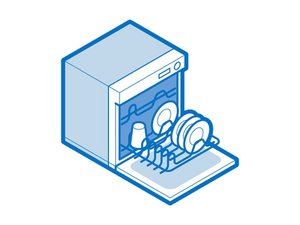Introduction
Safety First! Before you begin, remember that safety is paramount. Always disconnect your dishwasher from the power source before attempting any repairs or diagnostics. This precaution is crucial to prevent electric shock or damage to your appliance.
Understanding Your Dishwasher This guide covers various problems, from water not entering the dishwasher to issues with drying or leaks. We’ve broken down each problem into three key sections:
- Problem: Identifies the specific issue you're experiencing.
- Why It Happens: Provides a brief explanation of potential causes.
- How to Fix: Offers step-by-step solutions to resolve the issue.
Ready to Tackle the Problem? Armed with this guide, you can approach dishwasher troubleshooting with confidence. Let’s dive in and get your dishwasher running smoothly again!
Causes
Why It Happens?
The dishwasher might not be getting water due to several reasons like closed water supply, clogged parts, or electrical issues.
How to Fix
- Check if the water supply is turned on.
- Inspect the water inlet valve for voltage and any defects.
- Clean the water valve inlet screen and check for blockages.
- Examine the water fill line for any kinks.
- Ensure the drain hose is installed correctly to prevent water siphoning out.
- Test the door latch switches for continuity.
- Check the float assembly for obstructions and test the float switch.
- For electronic models, run the diagnostic test mode.
- Look for loose or burned wires, and check the float assembly again.
Why It Happens?
This issue could stem from inadequate water pressure or valve issues.
How to Fix
- Confirm water pressure is between 15 and 120 psi.
- Test water volume by filling a quart container in less than seven seconds.
- Clean the water valve inlet screen.
- For portable models, check the aerating snap adapter.
- Test the timer and electronic control for proper functioning.
- Inspect the float switch and adjust or replace if needed.
- Recheck the water fill line for any kinks.
- Refer to the service manual for the correct water level in the tub after the fill cycle.
Why It Happens?
This can be due to issues with spray arms, loading, or temperature.
How to Fix
- Check if the upper spray arm is moving and not clogged.
- Inspect the arm for splits and ensure dishes are loaded evenly.
- Clean the filter assembly and check the lower impeller.
- Confirm water temperature is at 140°F.
- Ensure proper detergent usage and check the dispenser.
- On some models, inspect filters for blockages.
Why It Happens?
Similar reasons to the upper rack, including spray arm or loading issues.
How to Fix
- Ensure the lower spray arm is moving and not obstructed.
- Check for any binding of the spray arm on the housing.
- Verify water temperature and detergent usage.
- Ensure dishes are loaded correctly.
- Check filters on certain models for blockages.
Why It Happens?
This could be due to low water temperature or malfunctioning components.
How to Fix
- Verify water supply temperature.
- Check the heater, wiring, timer, or electronic control board.
- Ensure correct voltage to the heater and inspect the heater fan assembly.
- Check the use of rinse aid and the level.
- Inspect the door baffle and vent system.
Why It Happens?
Leaks can occur due to faulty seals, overfilling, or spray arm issues.
How to Fix
- Inspect and clean the spray arm.
- Check the tub gasket and corner gaskets.
- Inspect the vent baffle gasket and corner gasket.
- Ensure no overfilling of water.
- Check door closure and gasket clips.
- Observe the user loading the dishwasher for correct method.
- Verify proper drainage and dishwasher leveling.
- Inspect the door liner and wetting agent dispenser.
Why It Happens?
Leaks here might be due to damage or loose fittings.
How to Fix
- Check the side inlet tube and pump assembly for leaks.
- Inspect the motor seals.
- Look for any damage or rust in the tub.
- Ensure tightness of the water inlet port and heater element nuts.
- Tighten all screws in the motor, pump assembly, and upper rack.
Why It Happens?
Could be due to electrical issues or mechanical faults.
How to Fix
- Ensure there's voltage to the timer motor or control board.
- Check if the timer cams are rotating.
- Verify correct wiring and check for a jammed timer.
- Test the selector switch and run diagnostic mode.
Why It Happens?
Electrical problems or physical obstructions can cause motor issues.
How to Fix
- For a non-operating motor: Check continuity at the windings, voltage to the motor, and for obstructions.
- For a motor going into overload: Check the relay, pump assembly, voltage, polarity, and motor windings. Test the run capacitor if present.
